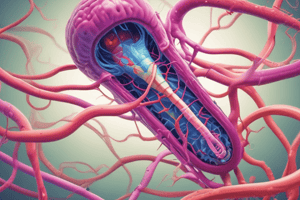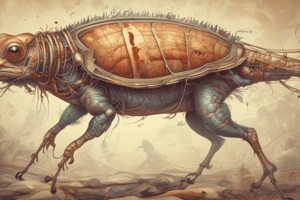Podcast
Questions and Answers
What is the common name for Dipylidium caninum?
What is the common name for Dipylidium caninum?
- Oval tapeworm
- Flea tapeworm
- Cucumber tapeworm
- Double-pored tapeworm (correct)
Where are the reproductive organs located in the mature segments of Dipylidium caninum?
Where are the reproductive organs located in the mature segments of Dipylidium caninum?
- At the anterior end
- At the posterior end
- Midways on each lateral margin (correct)
- Scattered throughout the segment
What is the shape of the eggs of Dipylidium caninum found in fecal samples?
What is the shape of the eggs of Dipylidium caninum found in fecal samples?
- Cylindrical
- Oval
- Irregular
- Spherical (correct)
What is the role of the intermediate hosts in the life cycle of Dipylidium caninum?
What is the role of the intermediate hosts in the life cycle of Dipylidium caninum?
Which of the following is the most common tapeworm of dogs in most parts of the world?
Which of the following is the most common tapeworm of dogs in most parts of the world?
What is the shape of the segments of the Dipylidium caninum tapeworm?
What is the shape of the segments of the Dipylidium caninum tapeworm?
What is the characteristic feature of the scolex of Dipylidium caninum?
What is the characteristic feature of the scolex of Dipylidium caninum?
Which part of the Dipylidium caninum tapeworm exhibits the presence of four unarmed suckers and an armed rostellum?
Which part of the Dipylidium caninum tapeworm exhibits the presence of four unarmed suckers and an armed rostellum?
What is the characteristic appearance of the ovary and vitelline glands in the mature segments of Dipylidium caninum?
What is the characteristic appearance of the ovary and vitelline glands in the mature segments of Dipylidium caninum?
Describe the scolex of Dipylidium caninum and its characteristic features.
Describe the scolex of Dipylidium caninum and its characteristic features.
What is the intermediate host for Dipylidium caninum?
What is the intermediate host for Dipylidium caninum?
Explain the differentiation between immature, mature, and gravid segments of Dipylidium caninum.
Explain the differentiation between immature, mature, and gravid segments of Dipylidium caninum.
What are the intermediate hosts of Dipylidium caninum and how do they contribute to its life cycle?
What are the intermediate hosts of Dipylidium caninum and how do they contribute to its life cycle?
Describe the appearance of the ovary and vitelline glands in the mature segments of Dipylidium caninum.
Describe the appearance of the ovary and vitelline glands in the mature segments of Dipylidium caninum.
What is the characteristic appearance of the eggs of Dipylidium caninum found in fecal samples?
What is the characteristic appearance of the eggs of Dipylidium caninum found in fecal samples?
Flashcards are hidden until you start studying
Study Notes
Dipylidium caninum
- Commonly known as the double-pored tapeworm
- Reproductive organs are located in the mature segments
Anatomy
- Scolex has four unarmed suckers and an armed rostellum
- Characteristic feature of the scolex is the presence of hooks
- Segments are rectangular in shape
- Ovary and vitelline glands in the mature segments are "H"-shaped
Life Cycle
- Intermediate hosts are fleas and lice
- Intermediate hosts contribute to the life cycle by ingesting eggs, allowing the parasite to develop
- The parasite completes its life cycle when the definitive host (dog) ingests an infected intermediate host
Segments
- Immature segments: undeveloped reproductive organs
- Mature segments: developed reproductive organs, contain eggs
- Gravid segments: contain fully developed eggs, ready to be released
Eggs
- Found in fecal samples, oval in shape
- Characteristic appearance: 30-40 μm in length, with a distinctive double-pored operculum
Studying That Suits You
Use AI to generate personalized quizzes and flashcards to suit your learning preferences.




